-
Home
-
Data & Publications
-
Regional Portals
- About Regional Portals
- Florida
- Navassa Island
- Puerto Rico
- Flower Garden Banks
- U.S. Virgin Islands
- American Samoa
- Commonwealth of the Northern Mariana Islands
- Federated States of Micronesia
- Guam
- Main Hawaiian Islands
- Republic of the Marshall Islands
- Northwestern Hawaiian Islands
- Republic of Palau
- Pacific Remote Island Areas
-
CRCP Activities
- Glossary
What are Coral Reefs
Appearing as solitary forms in the fossil record more than 400 million years ago, corals are extremely ancient animals that evolved into modern reef-building forms over the last 25 million years. Coral reefs are unique (e.g., the largest structures on earth of biological origin) and complex systems. Rivaling old growth forests in longevity of their ecological communities, well-developed reefs reflect thousands of years of history (Turgeon and Asch, in press).
Corals and their Kind
Corals are anthozoans, the largest class of organisms within the phylum Cnidaria. Comprising over 6,000 known species, anthozoans also include sea fans, sea pansies and anemones. Stony corals (scleractinians) make up the largest order of anthozoans, and are the group primarily responsible for laying the foundations of, and building up, reef structures. For the most part, scleractinians are colonial organisms composed of hundreds to hundreds of thousands of individuals, called polyps (Barnes, R.D., 1987; Lalli and Parsons, 1995).
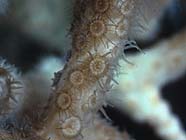
As members of the phylum Cnidaria, corals have only a limited degree of organ development. Each polyp consists of three basic tissue layers: an outer epidermis, an inner layer of cells lining the gastrovascular cavity which acts as an internal space for digestion, and a layer called the mesoglea in between (Barnes, R.D., 1987).
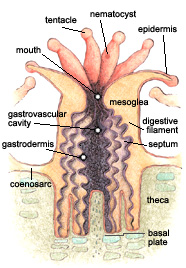
All coral polyps share two basic structural features with other members of their phylum. The first is a gastrovascular cavity that opens at only one end. At the opening to this cavity, commonly called the mouth, food is consumed and some waste products are expelled. A second feature all corals possess is a circle of tentacles, extensions of the body wall that surround the mouth. Tentacles help the coral to capture and ingest plankton for food, clear away debris from the mouth, and act as the animal’s primary means of defense (Barnes, R.D., 1987; Levinton, 1995).
While coral polyps have structurally simple body plans, they possess several distinctive cellular structures. One of these is called a cnidocyte—a type of cell unique to, and characteristic of, all cnidarians. Found throughout the tentacles and epidermis, cnidocytes contain organelles called cnidae, which include nematocysts, a type of stinging cell. Because nematocytes are capable of delivering powerful, often lethal toxins, they are essential to capturing prey, and facilitate coralline agonistic interactions (Barnes, R.D., 1987).
Most corals, like other cnidarians, contain a symbiotic algae called zooxanthellae, within their gastrodermal cells. The coral provides the algae with a protected environment and the compounds necessary for photosynthesis. These include carbon dioxide, produced by coral respiration, and inorganic nutrients such as nitrates, and phosphates, which are metabolic waste products of the coral. In return, the algae produce oxygen and help the coral to remove wastes. Most importantly, they supply the coral with organic products of photosynthesis. These compounds, including glucose, glycerol, and amino acids, are utilized by the coral as building blocks in the manufacture of proteins, fats, and carbohydrates, as well as the synthesis of calcium carbonate (CaCO3). The mutual exchange of algal photosynthates and cnidarian metabolites is the key to the prodigious biological productivity and limestone-secreting capacity of reef building corals (Barnes, R.D., 1987; Barnes, R.S.K. and Hughes, 1999; Lalli and Parsons, 1995; Levinton, 1995; Sumich, 1996).
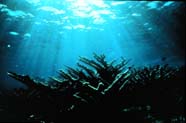
Zooxanthellae often are critical elements in the continuing health of reef-building corals. As much as 90% of the organic material they manufacture photosynthetically is transferred to the host coral tissue (Sumich, 1996). If these algal cells are expelled by the polyps, which can occur if the colony undergoes prolonged physiological stress, the host may die shortly afterwards. The symbiotic zooxanthellae also confers its color to the polyp. If the zooxanthellae are expelled, the colony takes on a stark white appearance, which is commonly described as “coral bleaching” (Barnes, R.S.K. and Hughes, 1999; Lalli and Parsons, 1995).
From Polyp to Reef
Massive reef structures are formed when each stony coral polyp secretes a skeleton of CaCO3. Most stony corals have very small polyps, averaging 1 to 3 mm in diameter, but entire colonies can grow very large and weigh several tons. Although all corals secrete CaCO3, not all are reef builders. Some corals, such as Fungia sp., are solitary and have single polyps that can grow as large as 25 cm in diameter. Other coral species are incapable of producing sufficient quantities of CaCO3 to form reefs. Many of these corals do not rely on the algal metabolites produced by zooxanthellae, and live in deeper and/or colder waters beyond the geographic range of most reef systems (Barnes, R.D., 1987; Sumich, 1996).

The skeletons of stony corals are secreted by the lower portion of the polyp. This process produces a cup, called the calyx, in which the polyp sits. The walls surrounding the cup are called the theca, and the floor is called the basal plate. Thin, calcareous septa (sclerosepta), which provide structural integrity, protection, and an increased surface area for the polyp’s soft tissues, extend upward from the basal plate and radiate outward from its center. Periodically, a polyp will lift off its base and secrete a new floor to its cup, forming a new basal plate above the old one. This creates a minute chamber in the skeleton. While the colony is alive, CaCO3 is deposited, adding partitions and elevating the coral. When polyps are physically stressed, they contract into the calyx so that virtually no part is exposed above the skeletal platform. This protects the organism from predators and the elements (Barnes, R.D., 1987; Sumich, 1996).
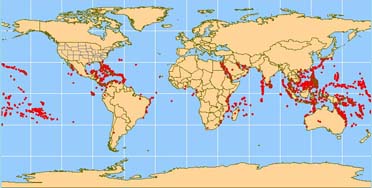
At other times, the polyp extends out of the calyx. The timing and extent to which a polyp extends from its protective skeleton often depends on the time of the day, as well as the species of coral. Most polyps extend themselves furthest when they feed on plankton at night.
In addition to a substantial horizontal component, the polyps of colonial corals are connected laterally to their neighbors by a thin horizontal sheet of tissue called the coenosarc, which covers the limestone between the calyxes. Together, polyps and coenosarc constitute a thin layer of living tissue over the block of limestone they have secreted. Thus, the living colony lies entirely above the skeleton (Barnes, R.S.K. and Hughes, 1999).

Colonies of reef-building (hermatypic) corals exhibit a wide range of shapes, but most can be classified within ten general forms. Branching corals have branches that also have (secondary) branches. Digitate corals look like fingers or clumps of cigars and have no secondary branches. Table corals are table-like structures of fused branches. Elkhorn coral has large, flattened branches. Foliose corals have broad plate-like portions rising above the substrate. Encrusting corals grow as a thin layer against the substrate. Submassive corals have knobs, columns or wedges protruding from an encrusting base. Massive corals are ball-shaped or boulder-like corals which may be small as an egg or large as a house. Mushroom corals resemble the attached or unattached tops of mushrooms. Cup corals look like egg cups or cups that have been squashed, elongated or twisted (McManus et al. 1997). While the growth patterns of stony coral colonies are primarily species-specific, a colony’s geographic location, environmental factors (e.g., wave action, temperature, light exposure), and the density of surrounding corals may affect and/or alter the shape of the colony as it grows (Barnes, R.D. 1987; Barnes, R.S.K. and Hughes 1999, Lalli and Parsons, 1995).
In addition to affecting the shape of a colony’s growth, environmental factors influence the rates at which various species of corals grow. One of the most significant factors is sunlight. On sunny days, the calcification rates of corals can be twice as fast as on cloudy days (Barnes, R.S.K. and Hughes, 1999). This is likely a function of the symbiotic zooxanthellae algae, which play a unique role in enhancing the corals’ ability to synthesize calcium carbonate. Experiments have shown that rates of calcification slow significantly when zooxanthellae are removed from corals, or when corals are kept in shade or darkness (Lalli and Parsons 1995).
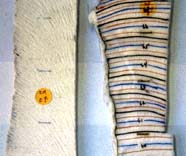
In general, massive corals tend to grow slowly, increasing in size from 0.5 cm to 2 cm per year. However, under favorable conditions (high light exposure, consistent temperature, moderate wave action), some species can grow as much as 4.5 cm per year. In contrast to the massive species, branching colonies tend to grow much faster. Under favorable conditions, these colonies can grow vertically by as much as 10 cm per year. This fast growth rate is not as advantageous as it may seem, however. Mechanical constraints limit the maximum size that branching corals can achieve. As they become larger, a heavier load is placed on the relatively small area attached to the substratum, rendering the colony increasingly unstable. Under these circumstances, the branches are prone to snapping off during strong wave action. The opposite is true of the massive-shaped corals, which become more stable as they grow larger (Barnes, R.S.K. and Hughes, 1999).
Where Reefs Exist
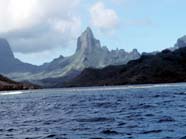
Reef-building corals are restricted in their geographic distribution. This is because the algal-cnidarian symbiotic machinery needs a narrow and consistent band of environmental conditions to produce the copious quantities of limestone necessary for reef formation. The formation of highly consolidated reefs only occur where the temperature does not fall below 18°C for extended periods of time. This specific temperature restriction -18°C- does not, however, apply to the corals themselves. In Japan, where this has been studied in detail, approximately half of all coral species occur where the sea temperature regularly falls to 14°C an approximately 25% occur where it falls to 11°C (Veron 2000). Many grow optimally in water temperatures between 23° and 29°C, but some can tolerate temperatures as high as 40°C for limited periods of time. Most require very salty (saline) water ranging from 32 to 42 parts per thousand. The water must also be clear to permit high light penetration. The corals’ requirement for high light also explains why most reef-building species are restricted to the euphotic (light penetration) zone, approximately 70 m (Lalli and Parsons, 1995).
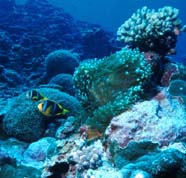
The number of species of corals on a reef declines rapidly in deeper water. High levels of suspended sediments can smother coral colonies, clogging their mouths which can impair feeding. Suspended sediments can also serve to decrease the depth to which light can penetrate. In colder regions, murkier waters, or at depths below 70 m, corals may still exist on hard substrates, but their capacity to secrete limestone is greatly reduced (Barnes, R.D., 1987).
In light of such stringent environmental restrictions, reefs generally are confined to tropical and semitropical waters. The diversity of reef corals, i.e., the number of species, decreases in higher latitudes up to about 30° north and south, beyond which reef corals are usually not found. Bermuda, at 32° north latitude, is an exception to this rule because it lies directly in the path of the Gulf Stream’s warming waters (Barnes, R.D., 1987).
Another factor that seems to affect the diversity of reef-building corals is the ocean in which they are located. At least 500 reef-building species are known to exist in the waters of the Indo-Pacific region. In comparison, the Atlantic Ocean contains approximately 62 known species. The fossil record shows that many species once found across the Atlantic, Pacific and Indian Oceans gradually went extinct in the Atlantic, where the affects of ice ages had strong impacts on the Caribbean area wherein most of the Atlantic reefs reside. Following the closure of the seaway between the Caribbean and the Pacific, several species of corals became restricted to the Caribbean (Veron 2000).
The Structure of Coral Reefs
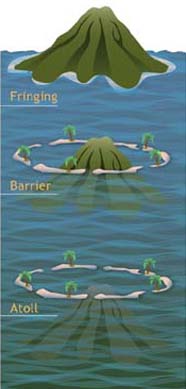
Coral reefs begin to form when free-swimming coral larvae (planulae) attach to the submerged edges of islands or continents. As the corals grow and expand, reefs take on one of three major characteristic structures—fringing, barrier or atoll.Fringing reefs, which are the most common, project seaward directly from the shore, forming borders along the shoreline and surrounding islands. Barrier reefs also border shorelines, but at a greater distance. They are separated from their adjacent land mass by a lagoon of open, often deep water. If a fringing reef forms around a volcanic island that subsides completely below sea level while the coral continues to grow upward, an atoll forms. Atolls are usually circular or oval, with a central lagoon. Parts of the reef platform may emerge as one or more islands, and breaks in the reef provide access to the central lagoon (Lalli and Parsons, 1995; Levinton, 1995; Sumich, 1996).
In the 1830s, Charles Darwin distinguished between the three main geomorphological categories of reefs, and suggested that fringing reefs, barrier reefs, and atolls were all related stages in the sequence of atoll reef formation.
All three reef types—fringing, barrier and atoll—share similarities in their biogeographic profiles.Bottom topography, depth, wave and current strength, light, temperature, and suspended sediments all act to create characteristic horizontal and vertical zones of corals, algae and other species. While these zones vary according to the location and type of reef, the major divisions common to most reefs, as they move seaward from the shore, are the reef flat, reef crest or algal ridge, buttress zone, and seaward slope.
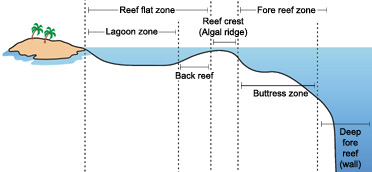
The reef flat, or back reef, is located on the sheltered side of the reef. It extends outward from the shore; and may be highly variable in character. Varying in width from 20 or 30 meters to more than a few thousand, the reef flat may range from only a few centimeters to a few meters deep, and large parts may be exposed at low tide. The substrate is formed of coral rock and loose sand. Beds of sea grasses often develop in the sandy regions, and both encrusting and filamentous algae are common.

Because it is so shallow, this area experiences the widest variations in temperature and salinity, but it is protected from the full force of breaking waves. Reduced water circulation, the accumulation of sediments, and periods of tidal emersions—when the reef is exposed during low tide—combine to limit coral growth. Although living corals may be scarce except near the seaward section of this zone, its many microhabitats support the greatest number of species in the reef ecosystem, with mollusks, worms and decapod crustaceans often dominating the visible macrofauna (Barnes, R.D., 1987; Lalli and Parsons, 1995; Sumich, 1996).
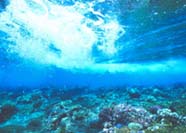
The reef crest, or algal ridge, is the highest point of the reef, and is exposed at low tide. Lying on the outer side of the reef, it is exposed to the full fury of incoming waves. The width of this zone typically varies from a few, to perhaps 50 m. In this severe habitat, a few species of encrusting calcareous red algae flourish, producing new reef material as rapidly as the waves erode it. Where wave action is severe, living corals are practically nonexistent, but in situations of more moderate wave action, the reef crest tends to be dominated by stoutly branching corals. These closely growing, robust colonies form ramparts able to withstand the heavy seas. Small crabs, shrimps, cowries and other animals reside in the labyrinthine subsurface cavities of the reef crest, protected from waves and predators (Barnes, R.D., 1987; Lalli and Parsons, 1995; Sumich, 1996).

The outermost seaward slope (also called the fore-reef) extends from the low-tide mark into deep water. Just below the low-tide mark to approximately 20 m depth is a rugged zone of spurs, or buttresses, radiating out from the reef. Deep channels that slope down the reef face are interspersed between the buttresses. These alternating spurs and channels may be several meters wide and up to 300 m long (Barnes, R.D. 1987; Lalli and Parsons, 1995; Sumich, 1996).
The buttress zone serves two main purposes in the reef system. First, it acts to dissipate the tremendous force of unabating waves and stabilizes the reef structure. Second, the channels between the buttresses drain debris and sediment off the reef and into deeper water. Massive corals and encrusting coralline algae thrive in this zone of breaking waves, intense sunlight, and abundant oxygen. Small fish inhabit the many holes and crevices on this portion of the reef, and many larger fish including sharks, jacks, barracudas and tunas patrol the buttresses and grooves in search of food (Barnes, R.D., 1987; Lalli and Parsons, 1995; Sumich, 1996).
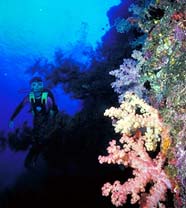
Continuing down the seaward slope to about 20 m, optimal light intensity decreases, but reduced wave action allows the maximum number of coral species to develop. Beginning at approximately 30 to 40 m, sediments accumulate on the gentle slope, and corals become patchy in distribution. Sponges, sea whips, sea fans, and ahermatypic (non-reef-building) corals become increasingly abundant and gradually replace hermatypic corals in deeper, darker water (Barnes, R.D., 1987; Lalli and Parsons, 1995; Sumich, 1996).
References
Barnes, R.D. 1987. Invertebrate Zoology; Fifth Edition. Fort Worth, TX: Harcourt Brace Jovanovich College Publishers. pp. 92-96, 127-134, 149-162.
Barnes, R.S.K. and R.N. Hughes. 1999. An Introduction to Marine Ecology; third edition. Oxford, UK: Blackwell Science Ltd. pp. 117-141.
Lalli, C.M. and T.R. Parsons. 1995. Biological Oceanography: An Introduction. Oxford, UK: Butterworth-Heinemann Ltd. pp. 220-233.
Levinton, J.S. 1995. Marine Biology: Function, Biodiversity, Ecology. New York: Oxford University Press, Inc. pp. 306-319.
McManus, J.W., M.C.A. Ablan, S.G. Vergara, B.M. Vallejo, L.A.B. Menez, K.P.K. Reyes, M.L.G. Gorospe and L. Halmarick, 1997. Reefbase Aquanaut Survey Manual. ICLARM Educational Series. 18, 61p.
Sumich, J.L. 1996. An Introduction to the Biology of Marine Life, sixth edition. Dubuque, IA: Wm. C. Brown. pp. 255-269.
Turgeon, D.D. and R.G. Asch. In Press. The State of Coral Reef Ecosystems of the United States and Pacific Freely Associated States. Washington D.C.; NOAA.
Veron, JEN. 2000. Corals of the World. Vol 3. Australia: Australian Institute of Marine Sciences and CRR Qld Pty Ltd.


